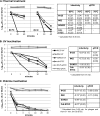Stability and infectivity of cytolethal distending toxin type V gene-carrying bacteriophages in a water mesocosm and under different inactivation conditions
- PMID: 22685154
- PMCID: PMC3406162
- DOI: 10.1128/AEM.00997-12
Stability and infectivity of cytolethal distending toxin type V gene-carrying bacteriophages in a water mesocosm and under different inactivation conditions
Abstract
Two cytolethal distending toxin (Cdt) type V-encoding bacteriophages (Φ62 and Φ125) were induced spontaneously from their wild-type Escherichia coli strains and from the lysogens generated in Shigella sonnei. The stability of Cdt phages was determined at various temperatures and pH values after 1 month of storage by means of infectivity tests using a plaque blot assay and analysis of phage genomes using real-time quantitative PCR (qPCR): both were highly stable. We assessed the inactivation of Cdt phages by thermal treatment, chlorination, UV radiation, and in a mesocosm in both summer and winter. The results for the two Cdt phages showed similar trends and were also similar to the phage SOM23 used for reference, but they showed a much higher persistence than Cdt-producing E. coli. Cdt phages showed maximal inactivation after 1 h at 70°C, 30 min of UV radiation, and 30 min of contact with a 10-ppm chlorine treatment. Inactivation in a mesocosm was higher in summer than in winter, probably because of solar radiation. The treatments reduced the number of infectious phages but did not have a significant effect on the Cdt phage particles detected by qPCR. Cdt phages were quantified by qPCR in 73% of river samples, and these results suggest that Cdt phages are a genetic vehicle and the natural reservoir for cdt in the environment.
Figures



Similar articles
-
Persistence of infectious Shiga toxin-encoding bacteriophages after disinfection treatments.Appl Environ Microbiol. 2014 Apr;80(7):2142-9. doi: 10.1128/AEM.04006-13. Epub 2014 Jan 24. Appl Environ Microbiol. 2014. PMID: 24463973 Free PMC article.
-
Evolution of a self-inducible cytolethal distending toxin type V-encoding bacteriophage from Escherichia coli O157:H7 to Shigella sonnei.J Virol. 2013 Dec;87(24):13665-75. doi: 10.1128/JVI.02860-13. Epub 2013 Oct 9. J Virol. 2013. PMID: 24109226 Free PMC article.
-
Bacteriophage-encoding cytolethal distending toxin type V gene induced from nonclinical Escherichia coli isolates.Infect Immun. 2011 Aug;79(8):3262-72. doi: 10.1128/IAI.05071-11. Epub 2011 Jun 6. Infect Immun. 2011. PMID: 21646456 Free PMC article.
-
Shiga toxin-encoding bacteriophages--genomes in motion.Int J Med Microbiol. 2004 Sep;294(2-3):115-21. doi: 10.1016/j.ijmm.2004.06.023. Int J Med Microbiol. 2004. PMID: 15493821 Review.
-
Inactivation of Dairy Bacteriophages by Thermal and Chemical Treatments.Viruses. 2019 May 25;11(5):480. doi: 10.3390/v11050480. Viruses. 2019. PMID: 31130656 Free PMC article. Review.
Cited by
-
Bacteriophage cocktail for biocontrol of Escherichia coli O157:H7: Stability and potential allergenicity study.PLoS One. 2018 May 15;13(5):e0195023. doi: 10.1371/journal.pone.0195023. eCollection 2018. PLoS One. 2018. PMID: 29763937 Free PMC article.
-
Human Virome and Disease: High-Throughput Sequencing for Virus Discovery, Identification of Phage-Bacteria Dysbiosis and Development of Therapeutic Approaches with Emphasis on the Human Gut.Viruses. 2019 Jul 18;11(7):656. doi: 10.3390/v11070656. Viruses. 2019. PMID: 31323792 Free PMC article. Review.
-
Abundance of antibiotic resistance genes in bacteria and bacteriophages isolated from wastewater in Shiraz.Mol Biol Res Commun. 2021 Jun;10(2):73-83. doi: 10.22099/mbrc.2021.39468.1584. Mol Biol Res Commun. 2021. PMID: 34316494 Free PMC article.
-
Persistence of infectious Shiga toxin-encoding bacteriophages after disinfection treatments.Appl Environ Microbiol. 2014 Apr;80(7):2142-9. doi: 10.1128/AEM.04006-13. Epub 2014 Jan 24. Appl Environ Microbiol. 2014. PMID: 24463973 Free PMC article.
-
UV-Sensitivity of Shiga Toxin-Converting Bacteriophage Virions Φ24B, 933W, P22, P27 and P32.Toxins (Basel). 2015 Sep 21;7(9):3727-39. doi: 10.3390/toxins7093727. Toxins (Basel). 2015. PMID: 26402701 Free PMC article.
References
-
- Ackermann HW, Tremblay D, Moineau S. 2004. Long-term bacteriophage preservation. WFCC Newsl. 38:35–40
-
- Anonymous 1998. Standard methods for the examination of water and wastewater, 20th ed American Public Health Association, American Works Association and Water Environmental Federation, Washington, DC
-
- Anonymous 2000. ISO 10705-2: water quality: detection and enumeration of bacteriophages. 2. Enumeration of somatic coliphages. International Organisation for Standardisation, Geneva, Switzerland
Publication types
MeSH terms
Substances
LinkOut - more resources
Full Text Sources

